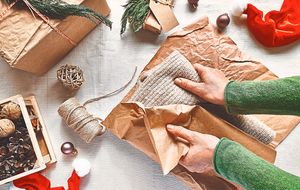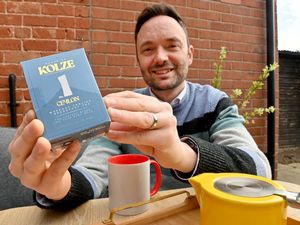How to have a green start to the New Year
Now Christmas is done and dusted and a new year is beginning, it’s time for the annual big clean up.

It can be tempting to deal with the piles of discarded wrapping paper, unwanted gifts and leftover food in the quickest way possible.
But if you’re looking to start the year off on the right note and help the planet at the same time then it’s worth taking a little extra time to prevent any items ending up in landfill unnecessarily.
Every year in the UK an extra 30 per cent of rubbish is produced and discarded throughout the festive period when compared with the rest of the year.
So what can we do to reduce all this waste?
RECYCLING
If you’ve ordered presents online, it’s likely you will have a collection of boxes or envelopes made from corrugated cardboard which is widely recycled by councils.
It’s estimated that 300,000 tonnes of cardboard is used in our homes during the festive season – enough to wrap Big Ben almost 260,000 times
Flatten cardboard boxes to make room in your recycling bin or bag and remember to remove any plastic or polystyrene inserts and excess sticky tape from cardboard boxes before recycling.
If your council does collect wrapping paper for recycling, only non-foil paper will be accepted.
To check, scrunch up the paper and if it doesn’t spring back it is non-foil and can be recycled.
Remember to also remove ribbons, bows, batteries and other adornments before recycling.
Some paper may be in a good enough condition to be used again so instead of throwing it away, keep it for next year.
Most cards are paper based and can be recycled, along with their envelopes, either in your home recycling collection, at local recycling points such as household waste recycling centres or at banks in supermarket car parks
But cards covered in glitter are not recyclable and any extras such as ribbons, glitter or bows need to be removed by tearing off that part of the card.
Alternatively, choose your favourite cards and cut them up to make gift tags for next
year’s presents.
Real Christmas trees can be recycled and turned into chippings for parks.
Some councils have special collections or organise drop-off points and they can be taken to your household waste recycling centre.
Many charities also offer tree recycling services in exchange for donations and will collect so you can help a good cause at the same time.
Natural materials on wreaths, such as ivy, fir cones, mistletoe and holly, can be composted as long as they are not covered with excessive glitter.
Simply remove the greenery from the base and add to your garden/green waste collection, or drop at your local household waste recycling centre. Artificial decorations such as ribbons and plastic flowers will need to be removed as these cannot be recycled.
All those new toys and gadgets mean more batteries to recycle. Some councils collect batteries bagged separately with household recycling but there are also many battery recycling points in shops.
Those selling more than 32kg of batteries a year - approximately 345 x four-packs of AA batteries - are required to provide battery recycling collection facilities in-store. This means there are now lots more places where you can take your old batteries for recycling.
If you have a new electrical appliance or gadget then think about recycling, donating or selling the old one.
FOOD
Not only is the wasted food a huge problem for landfill sites, but the production of these items and their packaging produce vast amounts of carbon emissions and greenhouse gases, as well as creating tonnes of packaging rubbish.
According to Love Food Hate Waste, throwing away just a single portion of Christmas dinner produces the same carbon emissions as having your Christmas lights on every day in December - that’s a set of 500 fairy lights, on for a total of 155 hours.
So take a look at what’s inside your fridge and decide what you and your household can realistically get through before it goes off.
If you’ve got more food left than you can get through while it’s still safe to eat, freeze these foods.
To maximise the space in your freezer, use freezer bags instead of food storage boxes to pack food away.
Then make a plan to use what’s left inside the fridge. Love Food Hate Waste’s leftovers recipe database has lots of ideas to use up ingredients, however random they might seem.
Don’t go grocery shopping until you’ve used up the food that needs eating as it will likely end up getting left and going bad before you get to it.
If you feel like you’ve bought too much food this Christmas, make a note of what was popular with family and guests and what didn’t get eaten so you only buy what they will eat next year.
Don’t forget to use a freezer pen to mark each bag or container with its contents and the date it was put in the freezer. This way, you can make sure nothing gets forgotten about. It can also be useful to keep an inventory list elsewhere and tick items off as you use them.
As well as not wanting to waste food, it’s also important not to throw away packaging that could be recycled. Plastic film is often not recyclable, but plastic containers should be, alongside plastic and glass bottles. If you’re unsure, check your local council’s website for information and restrictions
If you do find yourself with unopened packets in the cupboards that you’re never going to consume consider taking them to your local food bank.
UNWANTED GIFTS
They say it’s the thought that counts but there are always a few Christmas gifts that don’t quite hit the spot. Many plastic toys and the skincare/deodorant sets that we see each year end up discarded in landfill sites, with their materials taking hundreds of years to decompose - if it does at all. But there much more environmentally friendly options.
Nick Drewe, retail expert at online discount platform WeThrift, shares his top tips on how to get rid of unwanted gifts from Christmas.
Donate
It goes without saying that the best thing you can do with your unwanted gifts is to donate them to a good cause. When it comes to charity shop donations, make sure to apply for Gift Aid on your items. This is a form of tax relief that allows charities to claim an extra 25p on every £1 donation at no extra cost. In other words, your donation will be boosted!
Other than charity shops, you can also donate your unwanted toys to a children’s hospital, as well as any books to a school or library.
Sell
These days, you have more options than just eBay when it comes to selling your unwanted presents online. For example, there are websites and apps such as Depop, Vinted, Shpock and Facebook Marketplace which let you sell a wide range of items.
If you do decide to sell your unwanted Christmas presents on these platforms, it’s important that your item description is as detailed as possible. Be clear about the condition of the items, and if you’re dealing with clothes, list the right measurements. The more information you give about your product, the more likely it will sell quickly.
Recycle
You can also opt to do your bit and help save the planet with your unwanted presents. Retailers including John Lewis, M&S, Nike and H&M have schemes where they will buy back your unwanted clothes or shoes. If you’re wanting to recycle unwanted electronics, games and CDs, you can use websites such as MusicMagpie, which allow you to post your items for an agreed amount of cash.
Re-gift
If you think the present would be better suited for someone else, then you should have no shame in re-gifting an item to a friend, relative or acquaintance that will give it a better home. Doing this will guarantee that the gift won’t go to waste, and not to mention you’ll also be saving money on buying something new on the person’s birthday. Just simply re-wrap the present in fresh wrapping paper, or put it in a cute gift bag.
Return or exchange
To return or exchange your items, all that is required to take it back to the store is a proof of purchase. If a gift receipt was left in your present, you can use this to exchange the item for something else.
If there is no gift receipt, you’ll unfortunately have to ask the person who got the gift for a receipt. Likewise, if the present was bought online, it is the buyer’s responsibility to return or exchange it for something else. Obviously, this all boils down to how comfortable you are telling the person you don’t like their gift!
Repurpose
Alternatively, you can choose to keep hold of the present and turn it into something useful for yourself. For instance, you can use that unwanted top as a hair mask, or craft a fluffy tea towel out of that awful jumper. As well as this, if you love the style of a particular piece of clothing but hate its colour, perhaps give it a makeover by dying it. The DIY possibilities are endless!
For more tips see www.wethrift.com/tag/gifts
CLOTHES
The new year is the time when a lot of people clear out their wardrobe of anything that no longer fits or they no longer like. Or it could be that they’ve received new clothes for Christmas and want to make space for their gifts.
Around 336,000 tonnes of our unwanted clothing gets thrown away every year in the UK. The good news is that there are lots of simple ways to keep all clothing in use, and out of the bin.
Clothes and textiles that are in good condition can be donated to charities to be sold and reused, helping to minimise the overall impact that they have on the environment.
The Charity Retail Associations says that charity shops provide a sustainable and ethical option when people wish to dispose of unwanted clothes, books, furniture and other household items. They also give customers the option to buy clothes sustainably, whatever their budget.
Items that aren’t suitable to be passed onto someone else can be recycled and made into new items, such as padding for chairs and car seats, cleaning cloths and industrial blankets.
Charity shops are always on the lookout for clothing of all sizes that’s in good condition.
Many high street retailers such as Primark and M&S now offer clothing donation banks in-store. Primark accepts unwanted clothing, textiles, bags and footwear from any brand, in any condition. All items are recycled or repurposed if they can’t be reused and all profits donated to its charity partner, UNICEF.
While M&S runs its Shwopping recycling scheme in partnership with Oxfam. All clothing items that customers donate are sent to Oxfam to be resold in one of its shops or online, to be reused via its social enterprise in Senegal or to be recycled into new materials, which are used by businesses such as M&S’s mattress filling.
Alternatively, some council collect clothes and textiles to be recycled and clothing and textile banks can be found in supermarket and local car parks as well as at household waste sites.
Or if you want some money back for your items, you could consider selling them via the likes of Vinted, eBay and Facebook Marketplace.





